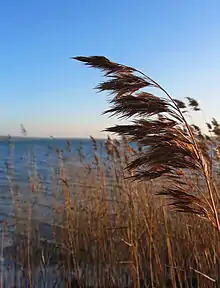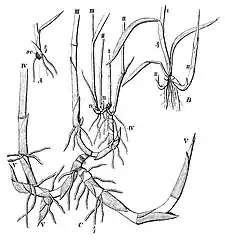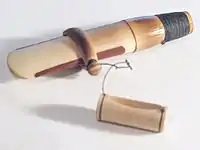Phragmites
Phragmites is a genus of four species of large perennial reed grasses found in wetlands throughout temperate and tropical regions of the world.
| Phragmites | |
|---|---|
 | |
| Phragmites australis seed head in winter | |
| Scientific classification | |
| Kingdom: | Plantae |
| Clade: | Tracheophytes |
| Clade: | Angiosperms |
| Clade: | Monocots |
| Clade: | Commelinids |
| Order: | Poales |
| Family: | Poaceae |
| Subfamily: | Arundinoideae |
| Tribe: | Molinieae |
| Subtribe: | Moliniinae |
| Genus: | Phragmites Adans. |
| Synonyms[1] | |
Taxonomy
The World Checklist of Selected Plant Families, maintained by Kew Garden in London, accepts the following four species:[2][1]
- Phragmites australis (Cav.) Trin. ex Steud. – cosmopolitan
- Phragmites japonicus Steud. – Japan, Korea, Ryukyu Islands, Russian Far East
- Phragmites karka (Retz.) Trin. ex Steud. – tropical Africa, southern Asia, Australia, some Pacific Islands
- Phragmites mauritianus Kunth – central + southern Africa, Madagascar, Mauritius

(From Om Skudbygning, Overvintring og Foryngelse by Eugen Warming, 1884)
The cosmopolitan common reed has the generally accepted botanical name Phragmites australis. (Cav.) Trin. ex Steud. About 130 other synonyms have been proposed,[1][3] and some have been widely used. Examples include Phragmites communis Trin., Arundo phragmites L., and Phragmites vulgaris (Lam.) Crép. (illegitimate name).[1]
Wildlife in reed beds
Common reed is very important (together with other reed-like plants) for wildlife and conservation, particularly in Europe and Asia, where several species of birds are strongly tied to large Phragmites stands. These include:
- Bearded reedling (Panurus biarmicus)
- Reed warbler (Acrocephalus scirpaceus)
- Great bittern (Botaurus stellaris)
In Australia, reedbeds provide cover for grassbirds (Megalurus spp.), reed warblers (Acrocephalus spp.), crakes (Porzana spp.) and bitterns (Ixobrychus spp.) and the Australian bittern (Botaurus poiciloptilus).
Uses
Cultivation
P. australis is cultivated as an ornamental plant in aquatic and marginal settings such as pond- and lakesides. Its aggressive colonisation means it must be sited with care.[4]
Phytoremediation water treatment
Phragmites australis is one of the main wetland plant species used for phytoremediation water treatment.
Waste water from lavatories and greywater from kitchens is routed to an underground septic tank-like compartment where the solid waste is allowed to settle out. The water then trickles through a constructed wetland or artificial reed bed, where bioremediation bacterial action on the surface of roots and leaf litter removes some of the nutrients in biotransformation. The water is then suitable for irrigation, groundwater recharge, or release to natural watercourses.
Thatching
Reed is used in many areas for thatching roofs. In the British Isles, common reed used for this purpose is known as Norfolk reed or water reed. However "wheat reed" and "Devon reed", also used for thatching, are not in fact reed, but long-stemmed wheat straw.
Music

In Middle East countries Phragmites is used to create a small instrument similar to the clarinet called a sipsi, with either a single, as in the picture, or double pipes as in bagpipes.[5] The reed of the zurna is made from the common reed which is flattened after removing its brittle outer glaze and the loose inner membrane, and after softening it by wetting.[6] The result is a double reed with an elliptical opening that vibrates by closing and opening at a high speed. This is not to be confused with other double reeds like that of the oboe which uses two reeds made from the giant reed leaning against each other.
Food
Numerous parts of Phragmites can be prepared for consumption. For example, the young stems "while still green and fleshy, can be dried and pounded into a fine powder, which when moistened is roasted [sic] like marshmallows." Also, the wheat-like seeds on the apex of the stems "can be ground into flour or made into gruel." Rootstocks are used similarly.[7]
Herbal medicine
The roots of reeds, as called in Chinese as 蘆根 or 葦莖, were used in traditional Chinese medicine to remedy illness related to the airways, including symptoms like cough with high fever, sticky and white (sometimes greenish) expectorated phlegm, etc.
Concoction of reed roots was believed to bring the fever away via increased urination and also help to restore body fluid.
Other uses
Some other uses for Phragmites australis and other reeds in various cultures include baskets, mats, Reed pen tips, (Qalam) and in Romania it was used to produce paper and other cellulose based products. Additionally, the reeds are used as nesting tubes by individuals keeping solitary bees such as mason bees.
In Egypt, the longer stems are dried and used as fishing poles. It is also used there for fences and cattle pens.
In the Philippines, Phragmites is known by the local name "tambo". Reed stands flower in December, and the blooms are harvested and bundled into brooms called "walis". Hence the common name of household brooms is "walis tambo".
Reeds have been used to make arrows[8] and weapons such as spears for hunting game.[9]
Gallery
 Reed growth in early summer
Reed growth in early summer Common reed in winter, Sudbury, MA, USA
Common reed in winter, Sudbury, MA, USA Phragmites in Amsterdam, Netherlands
Phragmites in Amsterdam, Netherlands Phragmites in Farmington, Utah[10]
Phragmites in Farmington, Utah[10].jpg.webp) Phragmites australis in the Great Lakes
Phragmites australis in the Great Lakes
References
- "The Plant List: Phragmites". Retrieved 2018-11-08.
- "Search: Phragmites". World Checklist of Selected Plant Families (WCSP). Retrieved 22 July 2020.
- "Common Reed - Phragmites australis - Synonyms - Encyclopedia of Life". Encyclopedia of Life.
- "RHS Plant Selector - Phragmites australis". Retrieved 26 May 2013.
- hitite musician (second millennia B.C.) playing double sips i
- "Norwegian food, recipes from Norway, Norwegian news and link directory fromnorway.net". www.fromnorway.net. Archived from the original on 2005-09-12.
- Peterson, Lee, "A Field Guide to Edible Wild Plants of Eastern and Central North America", page 228, Houghton Mifflin Company, New York City, accessed the sixth of September, 2010. ISBN 0-395-20445-3
- William C. Sturtevant (1978) Handbook of North American Indians: Great Basin, p. 269, Government Printing Office. ISBN 0160045819, 9780160045813.
- Unaipon, D. (2001) Legendary Tales of the Australian Aborigines, p. 138, The Miegunyah Press, Melbourne. ISBN 0-522-85246-7.
- "Phragmites in Great Salt Lake". Phragmites in Great Salt Lake.